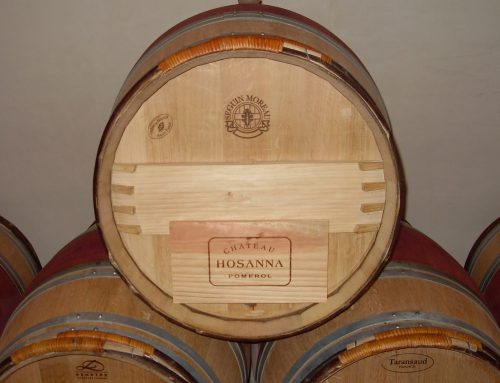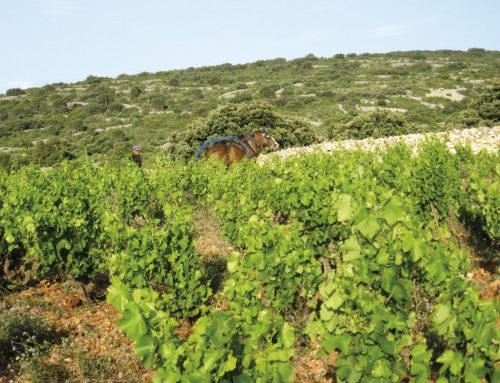Third in a four-part series
In October, I ate the grapes from the vines and sorting tables at the châteaux in Bordeaux. If you were a grape, you were plump and sweet. Last month, I discovered that throughout the Left Bank of the Gironde River, those grapes turned into delicious wines that can be summed up in a word: irresistible.
On the Left Bank, richly flavored red wines with integrated tannins enticed you to drink when you only intended to taste. And in Pessac-Léognan and Graves, dry white wines seduced you with tropical aromas and flavors.
The weather last year was simply perfect, says Oliver Bernard, owner of the esteemed Château de Chavalier. “From June to October, it was sunny and warm, but not too hot; it was cool during the night, but not too cold; we had rain, but not too much.”
While tasting the Left Bank’s 2009 vintage, I thought of 1990, another seductive vintage with luxuriant fruit and lush texture. When I returned home, I opened two 1990s from my cellar, Ch. Talbot and Clos du Jacobins. Twenty years later, the wines are still velvety and enormously pleasing. That’s a very good association for 2009.
The 2000 and 2005 vintages were also stellar, but more structured. But I think the 2009s will evolve with the 2000s. And that will make for great dinners with friends: a glass of the luxuriant 2009 next to the firm 2000. Life is good.
But before pivoting to the Right Bank, I’ll tip you off to my personal favorites from the Left Bank tastings:
• Margaux. Ch. Palmer, Ch. d’Issan, Ch. Brane-Cantenac, Ch. Prieure-Lichine, Ch. Kirwan, and Ch. Rauzan-Ségla. I have older vintages of each and plan to add their 2009.
• St. Julien. Ch. Beychevelle
• Pauillac. Ch. Latour is the wine version of the Iron Chef, and Ch. Lafite-Rothschild displays its trademark elegance. For decades, I have collected Ch. Pichon Baron de Longueville, Ch. Lynch-Bages, Ch. Duhart-Milon, Ch. Meyney (from St. Estèphe), and the second label wines of Ch. Latour and Ch. Lafite-Rothschild. The 2009s will join them.
• Pessac-Léognan: A place will be found for the mesmerizing red and white wines of Ch. Haut-Brion and Ch. La Mission Haut-Brion, and their delicious second wines; Ch. de Chevalier, which in my experience ages as well as the Haut-Brions; and Ch. Haut-Bailly, Ch. Pape-Clément and Ch. Smith Haut Lafitte. And don’t forget that not one of the 2009 white wines of Pessac-Léognan was rated less than very good.
Pomerol, the smallest of the major appellations, is synonymous with merlot. Located on the Right Bank, it is planted with 80 percent merlot, 15 percent cabernet franc and 5 percent cabernet sauvignon. Pomerol’s 150 châteaux comprise 2,000 acres, yielding a minuscule production to meet universal demand. Unlike the other major appellations in Bordeaux, there has never been a classification of Pomerol’s châteaux. However, the wine world recognizes Ch. Pétrus as the first among equals, and one of the most expensive wines on the planet.
On the fourth day of my tour, my morning blind tasting of the 2009 Pomerols treated my palate to one delicious wine after the next. Aromas and flavors of black fruit, mint and mild oak were stitched together with round, soft tannins yielding elegant, perfectly balanced wines. The 2009 Pomerols are voluptuous. Two days earlier, I found the wines of Margaux harmonious and merlot seemed to be the key. Now the hedonistic Pomerols said, “Welcome to the merlot vintage.”
• Extraordinary. Ch. Pétrus is seamless. It starts with a slightly smoky blackberry and black cherry aroma and continues with an elegant texture of black fruit and black tea flavors laced with silky tannins. It lingers on the palate like a long wave waiting to come ashore. It is pure merlot and 100 percent pleasure. Ch. La Conseillante’s enchanting floral and fruit aromas are foreplay for the delicious black cherry, mint and cinnamon flavors pleasing the palate.The long, velvety finish captures the OMG moment. Close your eyes and inhale the black cherry pie aroma of Clos du Clocher. Taste the rich blackberry and black olive flavors, and when the incredibly long finish is over, open your eyes and look at a wine label you’ve probably never seen before, but definitely will want to again. Ch. Le Moulin has a black cherry, minty nose and luscious blackberry, spicy fruit with harmonious tannins. Its finish was fathoms deep and long, making me realize that Pomerol is the place to be in 2009.
• Excellent: Ch. Plince, L’excellence du Ch. Gouprie, Ch. du Domaine de l’Eglise, Clos de la Vieille Eglise, Ch. Monregard La Croix, Ch. Vieux Maillet, Ch. Bonalque, Ch. l’Enclos, Ch. Petit-Village, Ch. Haut-Maillet, Ch. Beau Soleil, Ch. Gazin, Ch. Franc-Maillet, Ch. Pomeaux, Clos l’Église, Ch. Lafleur Gazin, Certan Marzelle, Ch. Latour, Ch. La Fleur-Pétrus, Ch. Providence, Ch. Hosanna, Ch. Certan de May and Ch. Trotanoy share a profile of billowing black fruit aroma with a mix of mint, cinnamon or floral scents; mouth-filling blackberry, black cherry and black olive flavors cascade across the palate with perfectly integrated tannins and a seemingly endless finish.
• Very good: Ch. La Clemence, Domaine de la Pointe, Ch. Lafleur du Roy, Ch. Gouprie, Ch. La Pointe, Ch. Mazeyres, Ch. La Cabanne, Ch. Bourgneuf-Vayron, Ch. Grand Moulinet, Ch. Tour Maillet, Esprit de l’Eglise (the second wine of Clos l’Église), Ch. Plincette, Ch. Grange Neuve, Ch. Tailhas, Ch. Le Cuyer, Ch. La Croix du Casse, Ch. Vray Croix de Gay, Ch. La Grave, and Ch. Bourgneuf exhibit lively black cherry, cherry, mint, or floral aromas and flavors. Integrated tannins and a very good finish are hallmarks of these well-made wines. Their separation from those marked excellent is a slightly lighter body or shorter finish. But some will evolve upward during the next two years.
• Good: Ch. de Sales, Ch. Beauregard, Clos du Canton Ormeaux and Ch. Clos René possess pleasant red fruit and mild oak aromas, tasty cherry-flavored fruit with good balance and an enjoyable finish.








Leave A Comment